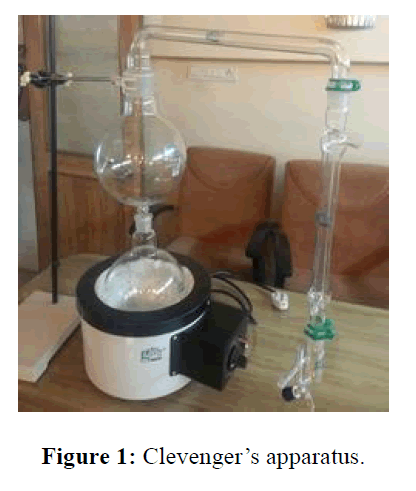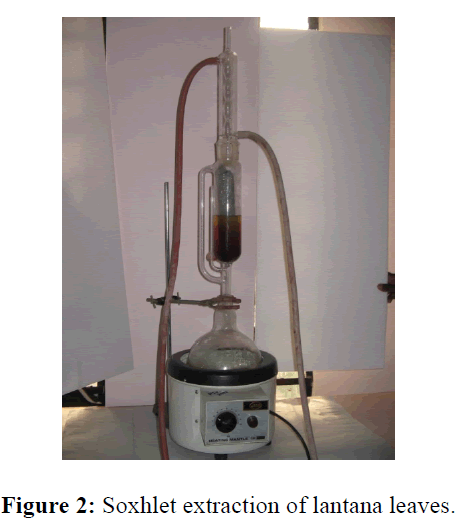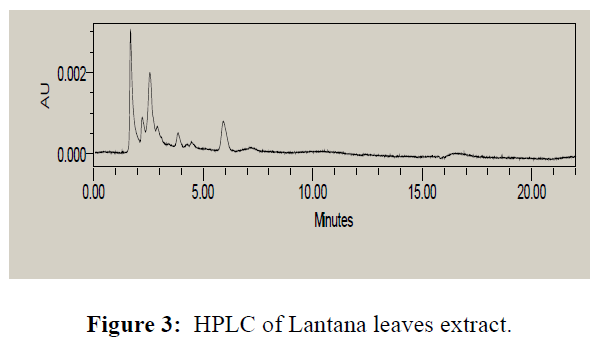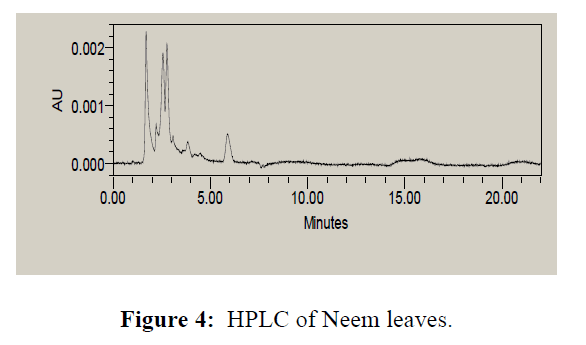Short Communication - (2019) Volume 11, Issue 3
Oil extracted from Neem leaves has been used as a mosquito repellent from ancient time. Modern commercial products available in the market for the use of mosquito repellents are chemical based and are found to be very harmful for human health. In this study preparation of a purely herbal product from the extracts of Neem leaf and Lantana leaf- flower through steam distillation was achieved. Both the plants are cheaply and abundantly available. The formulation was found to be effective and environment friendly. The efficacy of prepared Neem –Lantana combined essential oil and methanolic extract was evaluated for mosquito repellency. Based on the results obtained, the most effective repellency activity was achieved with 10% Neem-Lantana combination of oil and extract. Essential oils (EO) can have a synergistic effect in combination. Several modes of action have been put forward by which the essential oil components from different plants may act synergistically, such as by affecting multiple targets; by physicochemical interactions.
Mosquito repellency; Lantana oil; Neem oil; Synergy
Mosquitoes are big menace in tropical regions and the number of mosquito borne diseases is on the rise. Thus, there is a dire need of new and effective mosquito repellents for combating this problem. Although many products are available in the market having varying degrees of effectiveness, still a safer alternative is always needed. Several research papers have been published in the area of Natural and Chemical mosquito repellents. Most of the chemically synthesized mosquito repellents have pyrethroid such as Resmethrin, Permethrin,and d-phenothrin. These synthetic pyrethroids are popularly used to kill adult mosquitoes in mosquito control programs apart from d-transallethrin, d-allethrin and transfluthrin.
These mosquito repellents are toxic against the skin and nervous system. They also cause rashes, skin swelling due to irritation and hurt the eyes. Pyrethroids are not used as it is; they are mixed with a synergist compound, such as piperonyl butoxide. This compound enhances the effectiveness of the active pyrethroids ingredient and is used after diluting with water or oil. Both these products are toxic in nature. Hence, it was considered that natural mosquito repellents would be preferred and would have an edge chemical mosquito repellents analogue as they are non-toxic to human in most of the cases.
Scientist are in search of new active ingredients, especially those derived from natural sources such as plants to replace the synthetic pyrethroid [1,2]. It was envisaged that by many researchers that if individually they can be effective their synergistic effect may be surely more pronounced. It was observed by us that a mixture of 5 plants extracts namely- lemon grass, lantana, calotropis, tulsi and neem were used together, the effectiveness of the blended solution was enhanced due to some non-volatile components derived from calotropis, slowing down the repellency loss which is seen in volatiles mixtures if essential oils are the main component [2].
Traditionally plant-based repellents are still being used in rural communities in Asian subcontinent particularly in India and Srilanka because for they are the only means of protection from mosquito bites. It is also perceived that natural smelling repellents are preferred because plants are safe and trusted means of prevention [3,4]. Citronella oil has been one of the most popular extract which has demonstrated good efficacy against a large number of mosquitoes in concentrations ranging from 0.05% to 15% (w/v) alone or in combination with other natural or commercial repellent products [5]. The characteristic smell of citronella oil is due to the presence of citronellal, eugenol, geraniol and limonene. Essential oils from plants belonging to several species have been extensively tested to assess their repellent properties [6]. The repellency effect of these essential oil blends worked at 2% w/v which was as effective as synthetic repellents, it is an indication that further screening of different blends may lead to the new formulations with more repellent action. In most of the case essential oils (EO) can have a synergistic effect when mixed together. Scientist have suggested several modes of action by which the essential oil components from different plants may act synergistically, such as by affecting multiple targets or even by physicochemical interactions Many reported assays show additivity or synergism, indicating that EOs may offer possibilities for better mosquito repellency as compared to one EO.
In the present study Neem and Lantana leave extracts and their essential oils have been used together to check the effectivity on mosquito repellency. The desirable repellency was attributed to the chemical composition of the oils and the extracts, which worked against mosquitoes. The repellent efficiency of Neem oil+extract against mosquito was compared and it was found Neem oil+lantana oil+their extracts have been found to have better effectivity and provided 8-10 hours of repellency as compared to neem oil+extract, which could show repellency of 1.5-2.0 hours only. The chemical compositions of neem and lantana oils were examined and it was found that the crude essential oil consists of active ingredients – The main phytochemical compounds in Lantana consists of (triterpenoids), Oleanonic acid, Lantadene A, Lantadene B, Lantanilic acid, icterogenin and 4, 5- dihydroxy3, 7-dimethoxyflavone-4-o-beta D-glucopyranoside, Camaroside. These compounds were responsible for its repellency activity. Active constituents of Neem leaf extract include azadirachtin, isomeldenin, nimbin, nimbinene, 6-desacetyllnimbinene, nimbandiol, nimocinol, quercetin, and beta-sitosterol. As reported by earlier researchers most of the essential oil-based repellents tend to give short-lasting protection for less than two hours.
The present study showed better and longer repellency for mosquitos. The non-volatiles of the extract helped in prolonging the repellency effect.
Lantana (Lantana camara L.) plant leaves were collected. Before obtaining the essential oil, air dried leaves were weighed to calculate the yield percentage of essential oil.
Essential oil preparation from Neem leaves and Lantana leaves
Essential oil was obtained by means of hydro-distillation using a Clevenger apparatus (Figure 1) and a glass balloon of 2 L. 500 gms of leaves were taken for hydrodistillation in the case of Neem and Lantana. The procedure of essential oil extraction took 4-5 h after boiling had started. The essential oil was maintained in an amber glass recipient well closed, weighted and kept at -4°C.

Figure 1. Clevenger’s apparatus.
Methanolic extract preparation from Neem leaves and Lantana leaves
Separately leaves were taken weighing 200 gm. Soxhlet extraction of these leaves was carried out in methanol (3 cycles). Methanol was removed through rotavapour bath at 50°C under vacuum. Compound recovered was 63.25 gms of oily mass. The heating was not enhanced, by doing so efforts were made to try to preserve the volatiles along with non-volatiles.
Neem (Azadirachta indica) plant leaves were taken weighing 200 gm. Soxhlet extraction was carried out in ethanol/hexane mixture in 50:50 (3 cycles). Mixed solvent was removed through rotavapour bath at 50°C under vacuum. Neem oil recovered was 55 gms of oily mass. Precaution was taken to preserve the volatiles along with non-volatiles (Figure 2).

Figure 2. Soxhlet extraction of lantana leaves.
The hydrodistillate and the soxhlet extracts were mixed in 50:50 ratios of Neem and Lantana and used for repellent study.
Mosquito repellency test
Three major parameters were tested for the prepared samples-
a) Effective dose (ED) of the prepared natural repellent, b) Complete protection time (CPT) provided by the prepared repellent and finally after application and c) Duration of its effectivity. The bioassay method used was as follows: Treatment of 2.5%, 3.5% and 5% ethanolic solution of the pure extracts of Neem and lantana along with 50:50 blends of extracts of the two leaves. The mosquito prone areas were chosen for carrying out experimental study, particularly in the evening and night hours near the bushes in the garden, laboratory and public places to check the efficacy and effectivity. The effectivity of the natural repellent is tested by the landing and probing behavior of mosquitoes. The efficacy of the natural repellent prepared against mosquitoes was done by counting numbers of bites by mosquitoes per unit time, and percentage repellencies were calculated and statistically confirmed by counting. CPT was calculated by the time elapsed by repellent application and the first mosquito bite for each dose. Aedes aegypti mosquito was the species which was used in the study.
Analogous synergistic phenomena
Although repellent activity of essential oils is generally attributed to one particular compound, a synergistic phenomenon has been also observed which could arise among its components and may eventually result in a higher bioactivity compared to the isolated component [7], Researchers have often compared repellent activities between the essential oil and synthetic blends formulated with its major constituents. It has been observed that the activities were less significant than those of the corresponding EO giving an indication that sometimes even minor constituents may contribute to the repellent activity. Thus minor constituents may act as synergists, enhancing the effectiveness of the major constituents through a variety of mechanisms [8]. The high mosquito repellency of the mixed oils is assumed to have resulted from the synergistic action of the main compounds in the oils. However further investigation is required to understand the complete mechanisms involved in how the interactions between the components of each essential oil result in the improvement of repellent activities.
Essential oil repellent efficiency
Anther observation has been that the effective efficiency of EO has been when they are freshly prepared and applied; their protective effects usually dissipate relatively quickly over a period of time on exposure. This could be due to the fact that the volatiles evaporate at room temperature. Thus when Neem extract and lantana are mixed the effectiveness of the blended solution was enhanced due to some non-volatile components present in Lantana extract, slowing down the repellency loss, thus it is effective for a relatively longer period of time. The aim of new formulation development should be able to keep the active ingredients onto the skin for longer time periods. The increase in repellence activity for essential oils is largely dependent on the composition of the formulation and if synergy among the active components can take place that is added advantage and can result in very effective action.
Analytical data of the extracts of Lantana and Neem show the following results. High Pressure Liquid Chromatographic analysis of the individual extract gives the information of major components in each extract as shown (Figures 3 and 4).

Figure 3. HPLC of Lantana leaves extract.

Figure 4. HPLC of Neem leaves.
HPLC of Lantana leaves
Eluent Solvent System used for the analysis: 95:5 MeOH:H2O, with a Run Time of 22 min. The sample was prepared in methanol, Chromatogram taken on lamda max 280nm.
HPLC analysis of Neem leaves extract
Eluent Solvent System used was 95:5 MeOH:H2O, with a Run Time of 22 min. The sample was prepared in Methanol, Chromatogram taken on lamda max280nm.
Methods to assess repellent activity
By spraying the mixture of Essential oil and extract mixture (50: 50) of Neem and Lantana leaves on the exposed skin. This is not a standard protocol of analysis and hence is not fully perfect method of bioassay. There are several other factors which may influence the study of efficacy of any repellent. For example, spraying on the skin may cause some amount of absorption and evaporation of the volatiles of the extract mixture at the time of application or spraying, abrasion could also result with clothes, washing from the skin due to water spillage may also happen and loss could be also through perspiration, all this may cause a resultant loss in calculation of CPT (Complete Protection Time). The investigations were done under laboratory conditions and human volunteers were used. Results of concentrations only Neem, only Lantana and Neem+Lantana (EO+extracts) are shown in table (Table 1).
| S.No | Essential oil+Extract (50: 50) |
Percentage of Extract ( Effective dose ED) |
Effectivity as CPT |
|---|---|---|---|
| 1 | Neem oil+Extract | 2.50% | 1 hour |
| 3.50% | 1.5 hours | ||
| 5.00% | 2.0 hours | ||
| 2 | Lantana oil+Extract | 2.50% | 1.5 hours |
| 3.50% | 2.0 hours | ||
| 5.00% | 2.2 hours | ||
| 3 | Neem+Lantana oils+Extracts | 2.5 % each | 3-4 hours |
| 3.5 % each | 5-6 hours | ||
| 5.0 % each | 8-10 hours |
Table 1: Neem and Lantana extracts+Essential oils percentage composition.
It is an established fact that essential oils derived from commonly available plants have demonstrated potential for repellent activity against mosquitoes. However, pure essential oils have high volatility which decreases the time duration of protection action. We have used the leaves extracts of Neem and Lantana, which contained non volatiles too, thus it showed very good mosquito repellency for longer duration. Thus it was envisaged that if individually they were effective, however their synergistic effect has shown surely more pronounced effect. Thus when Neem and lantana were used together, the effectiveness of the blended solution was enhanced due to some non-volatile components slowing down the repellency loss which is seen in volatiles mixtures. Although the repellency of these blends at 2.5% w/v was low, but with 5.0% of each, the blend showed improved repellency considerably. Thus it can be concluded that the blended extract solution has the potential to be used as a repellent against mosquitoes very well.
These aromatic plants can also be used for the preparation of other insect repellents and will have scope for other value addition products for both Indian and Srilankan markets. Technique for extraction is easy therefore it is certainly techno-economically viable. Neem and Lantana are abundantly available and need no special care to grow these plants. The study of the synergistic effects among constituents of EO and mixtures of oils, as well as the search of new plant extracts that could make longer the protection times is further being explored.
Authors also express their sincere thanks to University of Moratuwa, Sri Lanka for financial support extended through Senate Research Grant (SRC) and Facility for Ecological Laboratory, IIT, Kanpur, India for assisting to carry out testing and analysis of the research.
Copyright:This is an open access article distributed under the terms of the Creative Commons Attribution License, which permits unrestricted use, distribution, and reproduction in any medium, provided the original work is properly cited.